把一本《白话深度学习与tensorflow》给啃完了,了解了一下基本的BP网络,CNN,RNN这些。感觉实际上算法本身不是特别的深奥难懂,最简单的BP网络基本上学完微积分和概率论就能搞懂,CNN引入的卷积,池化等也是数字图像处理中比较成熟的理论,RNN使用的数学工具相对而言比较高深一些,需要再深入消化消化,最近也在啃白皮书,争取从数学上把这些理论吃透
当然光学理论不太行,还是得要有一些实践的,下面是三个入门级别的,可以用来辅助对BP网络的理解
环境:win10 WSL ubuntu 18.04
1.线性回归
入门:tensorflow线性回归
https://zhuanlan.zhihu.com/p/37368943
代码:
from __future__ import print_function
import tensorflow as tf
import numpy
import matplotlib.pyplot as plt
rng = numpy.random
# Parameters
learning_rate = 0.01
training_epochs = 1000
display_step = 50
save_step = 500
# Training Data
train_X = numpy.asarray([3.3, 4.4, 5.5, 6.71, 6.93, 4.168, 9.779, 6.182, 7.59, 2.167,
7.042, 10.791, 5.313, 7.997, 5.654, 9.27, 3.1])
train_Y = numpy.asarray([3, 4.7, 5, 7.21, 6.93, 4.168, 9.779, 6.182, 7.59, 2.167,
7.042, 10.291, 5.813, 7.997, 5.654, 9.17, 3.2])
# define graph input
X = tf.placeholder(dtype=tf.float32, name="X")
Y = tf.placeholder(dtype=tf.float32, name="Y")
with tf.variable_scope("linear_regression"):
# set model weight
W = tf.get_variable(initializer=rng.randn(), name="weight")
b = tf.get_variable(initializer=rng.randn(), name="bias")
# Construct a linear model
mul = tf.multiply(X, W, name="mul")
pred = tf.add(mul, b, name="pred")
# L2 loss
with tf.variable_scope("l2_loss"):
loss = tf.reduce_mean(tf.pow(pred-Y, 2))
# Gradient descent
train_op = tf.train.GradientDescentOptimizer(learning_rate).minimize(loss)
# Initialize the variables
init_op = tf.global_variables_initializer()
# Checkpoint save path
ckpt_path = './ckpt/linear-regression-model.ckpt'
# create a saver
saver = tf.train.Saver()
# Summary save path
summary_path = './ckpt/'
# Create a summary to monitor tensors which you want to show in tensorboard
tf.summary.scalar('weight', W)
tf.summary.scalar('bias', b)
tf.summary.scalar('loss', loss)
# Merges all summaries collected in the default graph
merge_summary_op = tf.summary.merge_all()
# Start training
with tf.Session() as sess:
summary_writer = tf.summary.FileWriter(summary_path, sess.graph)
# Run the initializer
sess.run(init_op)
# Fit all training data
for epoch in range(training_epochs):
for (x, y) in zip(train_X, train_Y):
# Do feed dict
_, summary = sess.run([train_op, merge_summary_op], feed_dict={X: x, Y: y})
if (epoch + 1) % save_step == 0:
# Do save model
save_path = saver.save(sess, ckpt_path, global_step=epoch)
print("Model saved in file %s" % save_path)
if (epoch + 1) % display_step == 0:
# Display loss and value
c = sess.run(loss, feed_dict={X: train_X, Y: train_Y})
print("Epoch:", "%04d" % (epoch+1), "loss=", "{:.9f}".format(c),
"W=", W.eval(), "b=", b.eval())
# Add variable state to summary file
summary_writer.add_summary(summary, global_step=epoch)
print("Optimization finished")
# Save the final model
summary_writer.close()
# Calculate final loss after training
training_loss = sess.run(loss, feed_dict={X: train_X, Y: train_Y})
print("Training loss=", training_loss, "W=", sess.run(W), "b=", sess.run(b), '
')
plt.plot(train_X, train_Y, 'ro', label='Origin data')
plt.plot(train_X, sess.run(W) * train_X + sess.run(b), label='fitted line')
plt.legend()
plt.show()
使用tensorboard的方法:
tensorboard --logdir=./ckpt/ (程序中存储summary的地址)
然后在浏览器输入
127.0.0.1:6006
即可查看
我训练的时候出现过loss不降反升的问题,说明选择的学习率有问题

除了学习率之外,学习的效果和优化算法的选择也有关系,我一开始选择的是梯度下降算法
train_op = tf.train.GradientDescentOptimizer(learning_rate).minimize(loss)
但是效果很不好


而更换优化算法为
train_op = tf.train.AdamOptimizer(learning_rate).minimize(loss)
效果好了不少

loss也比梯度下降小了一倍多

关于各个梯度算法的介绍
https://ruder.io/optimizing-gradient-descent/index.html
https://zhuanlan.zhihu.com/p/22252270
SGD(随机梯度下降)的缺点:
由于从头至尾使用的学习率完全一致,难以选择合适的学习率
容易困于鞍点(可以通过合适的初始化和step size克服)
而Adam算法通过引入梯度的一阶矩和二阶矩估计,引入了近似于动量和摩擦力的物理性质,使得训练具有了自适应性,所以比单纯的梯度下降往往要好用一些。
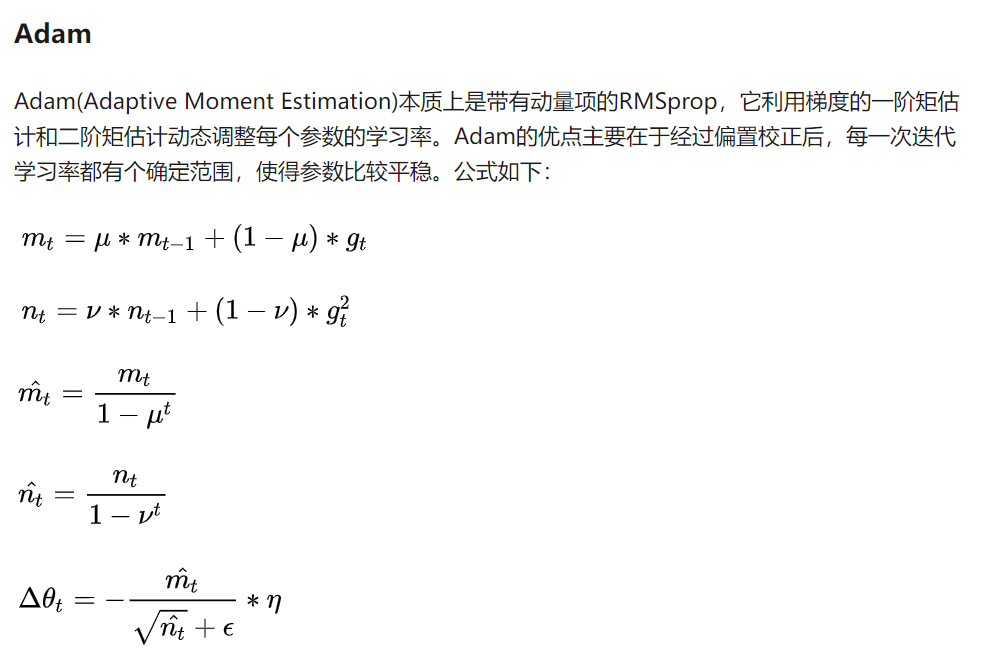
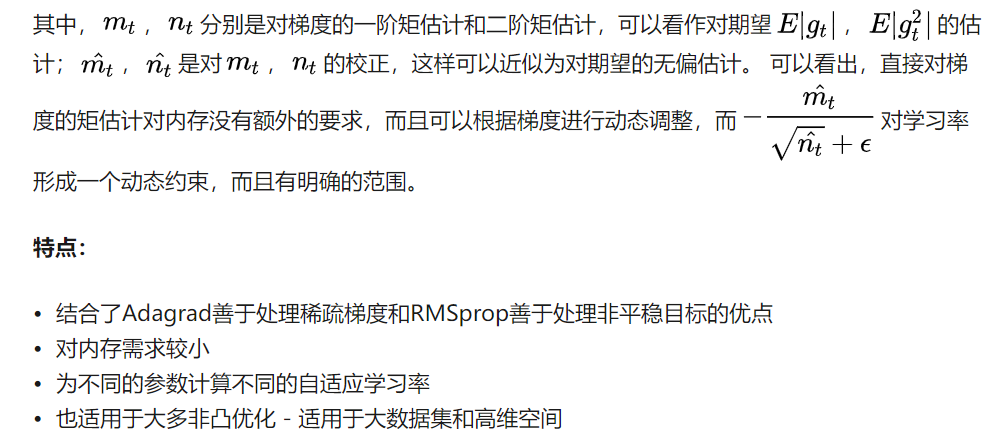
借助tensorboard可视化的观察loss,bias和weight的变化还是比较方便的,另外查看graph的功能也很好用


使用checkpoint保存的模型:
1.定义一个一模一样的graph,然后导入,可以发现创建图的过程和线性回归的代码一模一样的,创建完毕之后最关键的就是创建tf.train.Saver(),然后调用Saver类下面的restore方法,参数一个是sess一个是ckpt文件的路径
2.直接导入meta文件,这样可以将graph和参数一起导入
1.代码
from __future__ import print_function
import tensorflow as tf
import matplotlib.pyplot as plt
import numpy
rng = numpy.random
X = tf.placeholder(dtype=tf.float32, name="X")
Y = tf.placeholder(dtype=tf.float32, name="Y")
with tf.variable_scope("linear_regression"):
W = tf.Variable(rng.randn(), name="weight")
b = tf.Variable(rng.randn(), name="bias")
mul = tf.multiply(X, W, name="mul")
pred = tf.add(mul, b, name="pred")
saver = tf.train.Saver()
ckpt_path = './ckpt/linear-regression-model.ckpt-999'
with tf.Session() as sess:
saver.restore(sess, ckpt_path)
print('Restored Value W={}, b={}'.format(W.eval(),b.eval()))
结果:

2.代码
采用import_meta_graph导入graph,需要筑起启动Session时要设置参数config=config
调用graph中的tensor时可以直接使用graph.get_tensor_by_name
from __future__ import print_function
import tensorflow as tf
import matplotlib.pyplot as plt
import numpy
config = tf.ConfigProto(allow_soft_placement=True)
*# path of the .meta file*
ckpt = './ckpt/linear-regression-model.ckpt-999'
with tf.Session(config=config) as sess:
saver = tf.train.import_meta_graph(ckpt + '.meta')
saver.restore(sess, ckpt)
graph = sess.graph
X = graph.get_tensor_by_name("X:0")
pred = graph.get_tensor_by_name("linear_regression/pred:0")
W = graph.get_tensor_by_name("linear_regression/weight:0")
b = graph.get_tensor_by_name("linear_regression/bias:0")
print('Restored value W={}, b={}'.format(W.eval(), b.eval()))
结果:

2.非线性回归
https://blog.csdn.net/y12345678904/article/details/77743696
线性回归中使用的multiply(),但是由于实际使用中都是矩阵相乘,所以matmul更加的常用一些
tf.matmul() 和tf.multiply() 的区别
1.tf.multiply()两个矩阵中对应元素各自相乘
格式: tf.multiply(x, y, name=None)
参数:
x: 一个类型为:half, float32, float64, uint8, int8, uint16, int16, int32, int64, complex64, complex128的张量。
y: 一个类型跟张量x相同的张量。
返回值: x * y element-wise.
注意:
(1)multiply这个函数实现的是元素级别的相乘,也就是两个相乘的数元素各自相乘,而不是矩阵乘法,注意和tf.matmul区别。
(2)两个相乘的数必须有相同的数据类型,不然就会报错。
2.tf.matmul()将矩阵a乘以矩阵b,生成a * b。
格式: tf.matmul(a, b, transpose_a=False, transpose_b=False, adjoint_a=False, adjoint_b=False, a_is_sparse=False, b_is_sparse=False, name=None)
参数:
a: 一个类型为 float16, float32, float64, int32, complex64, complex128 且张量秩 > 1 的张量。
b: 一个类型跟张量a相同的张量。
transpose_a: 如果为真, a则在进行乘法计算前进行转置。
transpose_b: 如果为真, b则在进行乘法计算前进行转置。
adjoint_a: 如果为真, a则在进行乘法计算前进行共轭和转置。
adjoint_b: 如果为真, b则在进行乘法计算前进行共轭和转置。
a_is_sparse: 如果为真, a会被处理为稀疏矩阵。
b_is_sparse: 如果为真, b会被处理为稀疏矩阵。
name: 操作的名字(可选参数)
返回值: 一个跟张量a和张量b类型一样的张量且最内部矩阵是a和b中的相应矩阵的乘积。
注意:
(1)输入必须是矩阵(或者是张量秩 >2的张量,表示成批的矩阵),并且其在转置之后有相匹配的矩阵尺寸。
(2)两个矩阵必须都是同样的类型,支持的类型如下:float16, float32, float64, int32, complex64, complex128。
代码:
import tensorflow as tf
import numpy as np
import matplotlib.pyplot as plt
learning_rate = 0.1
training_epochs = 20000
display_step = 500
x_data = np.linspace(-1,1,200)
x_data = x_data.reshape((200,1))
noise = np.random.normal(0, 0.05, x_data.shape)
y_data = np.square(x_data) + noise
x = tf.placeholder(tf.float32, [200,1])
y = tf.placeholder(tf.float32, [200,1])
# hidden layer
weights_l1 = tf.Variable(tf.random_normal([1, 10]))
biases_l1 = tf.Variable(tf.zeros([1, 10]))
wx_plus_b_l1 = tf.matmul(x, weights_l1) + biases_l1
l1 = tf.nn.tanh(wx_plus_b_l1)
# output layer
weights_l2 = tf.Variable(tf.random_normal([10,1]))
biases_l2 = tf.Variable(tf.zeros([1,1]))
wx_plus_b_l2 = tf.matmul(l1, weights_l2) + biases_l2
prediction = tf.nn.tanh(wx_plus_b_l2)
# loss function
loss = tf.reduce_mean(tf.square(y - prediction))
# gradient descent
train_step = tf.train.GradientDescentOptimizer(learning_rate).minimize(loss)
with tf.Session() as sess:
sess.run(tf.global_variables_initializer())
for global_epochs in range(training_epochs):
sess.run(train_step, feed_dict={x:x_data, y:y_data})
if (global_epochs + 1) % display_step == 0:
loss_value = sess.run(loss, feed_dict={x:x_data, y:y_data})
print("epoch:", "%04d" %(global_epochs + 1), "loss=", "{:.9f}".format(loss_value))
prediction_value = sess.run(prediction, feed_dict={x:x_data})
plt.figure()
plt.scatter(x_data, y_data)
plt.plot(x_data, prediction_value,'r-',lw=3)
plt.show()
结果:
下降的效果还是比较明显的,从0.0076一直下降到了0.0027
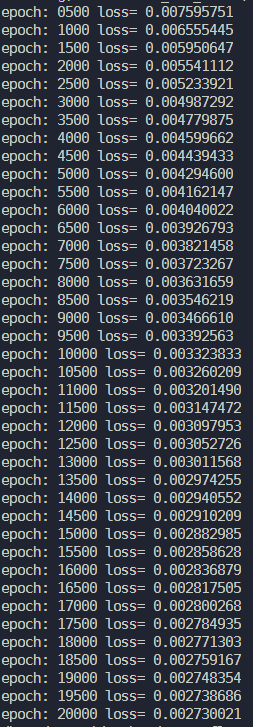
图像:
Gradient Descent的结果,比较符合二次曲线的分布规律
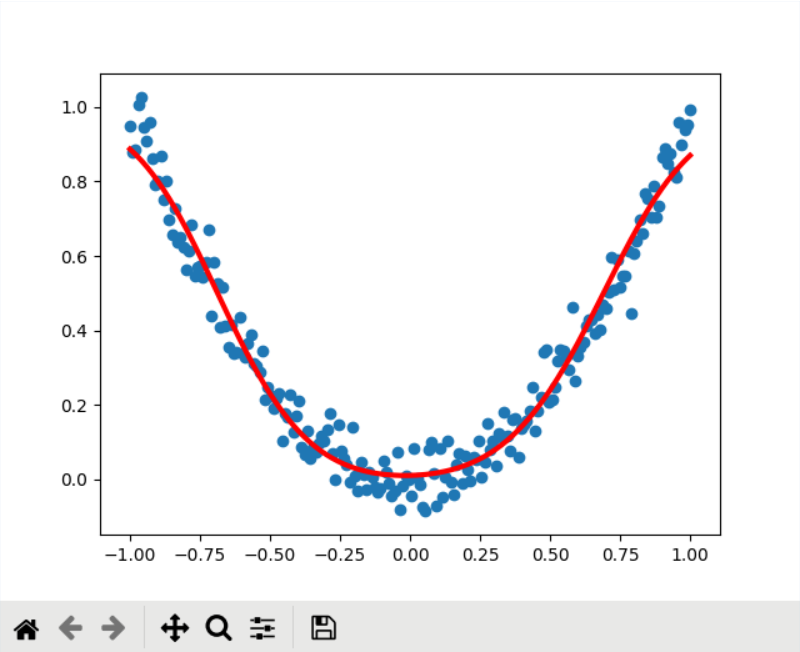
Adam的结果,虽然loss比Gradient Descent小,但是实际上有比较明显的过拟合了
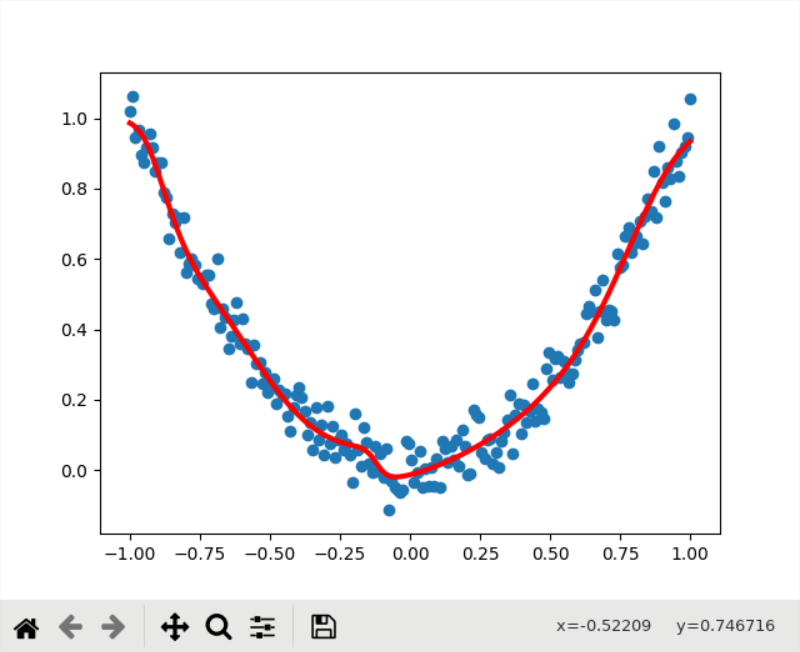
另外这里的激活函数采用的是tanh,更换成sigmoid之后
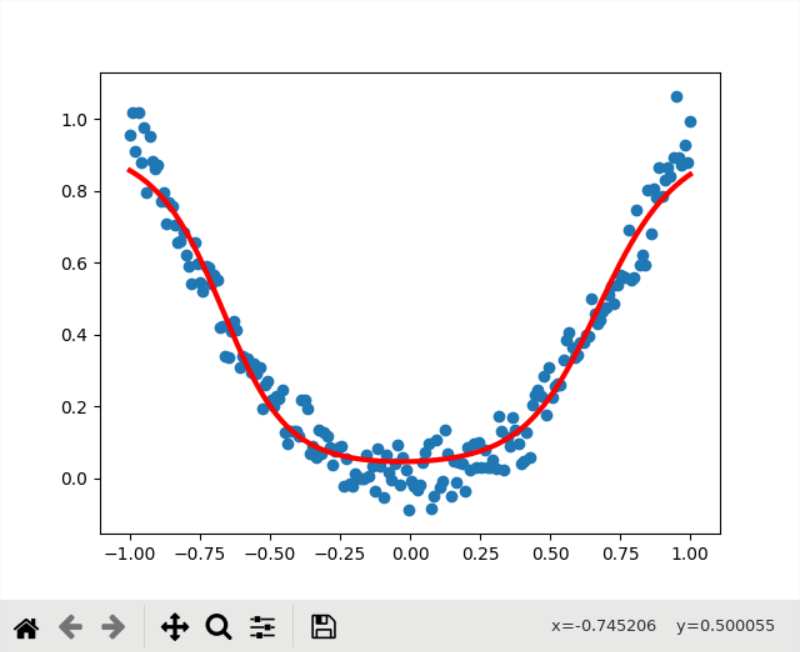

效果差于tanh做激活函数,因为tanh的导数值大于sigmoid,收敛速度实际上是快于sigmoid的,不过我把训练次数翻到了40000次后发现好像sigmoid作为激活函数,训练的上限就是0.004几了,而如果采用ReLU的话,就直接起飞了,根本无法收敛
ReLU还是适合在深度网络中做激活函数,在这种就一层的网络里面来搞效果就比较差(本来的目的就是为了解决深度网络中的梯度爆炸)
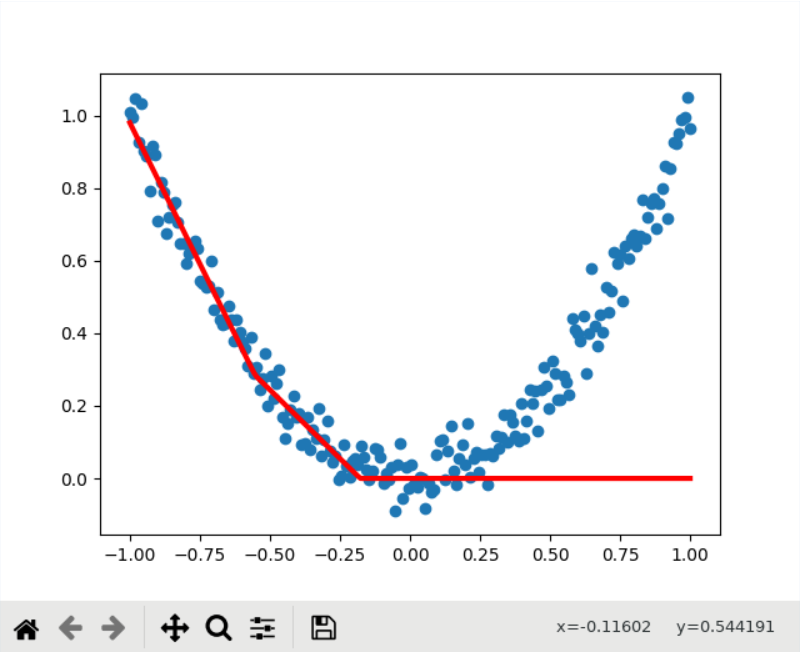
3.全连接网络实例(mnist)
https://geektutu.com/post/tensorflow-mnist-simplest.html
分为一个mnist_model.py用于构建网络,一个mnist_train.py用于训练,这种构建方式是大多数神经网络都会采取的方式
一维向量既可以用[1, 维数]来表示,也可以用[None, 维数]来表示
l由于label采用了1-10的独热编码,loss函数使用的是交叉熵,公式为(p为真实分布,q为非真实分布)

代码为
self.loss = -tf.reduce_sum(self.label * tf.log(self.y + 1e-10))
这里加1e-10的目的是为了防止y=0时出现数值溢出错误
关于feed_dict
sess.run() 中的feed_dict
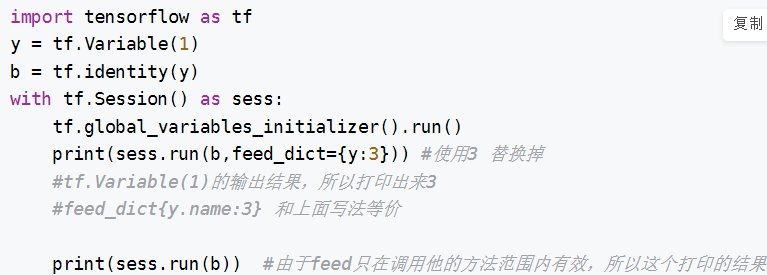
结果是1,本质上就是一个临时赋值的功能
model的代码:
import tensorflow as tf
class Network:
def __init__(self):
# learning rate
self.learning_rate = 0.01
# input tensor
self.x = tf.placeholder(tf.float32, [None, 784])
# label tensor
self.label = tf.placeholder(tf.float32, [None, 10])
# weight
self.w = tf.Variable(tf.random_normal([784, 10]))
# bias
self.b = tf.Variable(tf.random_normal([10]))
# output tensor
self.y = tf.nn.softmax(tf.matmul(self.x, self.w) + self.b)
# loss
self.loss = -tf.reduce_sum(self.label * tf.log(self.y + 1e-10))
# train
self.train = tf.train.GradientDescentOptimizer(self.learning_rate).minimize(self.loss)
# verify
predict = tf.equal(tf.arg_max(self.label, 1), tf.arg_max(self.y, 1))
# calc the accuracy
self.accuracy = tf.reduce_mean(tf.cast(predict, "float"))
train的代码:
train的代码
import tensorflow as tf
from tensorflow.examples.tutorials.mnist import input_data
from mnist_model import Network
class Train:
def __init__(self):
self.net = Network()
# initialize session
self.sess = tf.Session()
# initialize variables
self.sess.run(tf.global_variables_initializer())
# input data
self.data = input_data.read_data_sets('/home/satori/python/tensorflow_test/data_set', one_hot=True)
# create a saver
self.saver = tf.train.Saver()
def train(self):
batch_size = 64
train_epoch = 10000
save_interval = 1000
display_interval = 100
ckpt_path = './ckpt/mnist-model.ckpt'
for step in range(train_epoch):
x, label = self.data.train.next_batch(batch_size)
# training
self.sess.run(self.net.train, feed_dict={self.net.x:x, self.net.label:label})
if (step + 1) % display_interval == 0:
# print the loss
loss = self.sess.run(self.net.loss, feed_dict={self.net.x:x, self.net.label:label})
print("step=%d, loss=%.2f" %((step+1), loss))
if (step + 1) % save_interval == 0:
# save the model
self.saver.save(self.sess, ckpt_path, global_step=step)
print("model saved in file %s" %ckpt_path)
def calculate_accuracy(self):
test_x = self.data.test.images
test_label = self.data.test.labels
# using the net trained
accuracy = self.sess.run(self.net.accuracy, feed_dict={self.net.x: test_x, self.net.label: test_label})
print("accuracy=%.2f,%dof pictures are tested" %(accuracy,len(test_label)))
if __name__ == "__main__":
app = Train()
app.train()
app.calculate_accuracy()
train中会保存模型,然后我们需要将模型导入predict,对样本进行识别
import numpy as np
import tensorflow as tf
from PIL import Image
from mnist_model import Network
ckpt_path = './ckpt/mnist-model.ckpt-9999'
class Predict:
def __init__(self):
# restore the network
self.net = Network()
self.sess = tf.Session()
self.sess.run(tf.global_variables_initializer())
self.restore()
def restore(self):
saver = tf.train.Saver()
saver.restore(self.sess, ckpt_path)
def predict(self, image_path):
# turn image into black and white
img = Image.open(image_path).convert('L')
flatten_img = np.reshape(img, 784)
x = np.array([1 - flatten_img])
y = self.sess.run(self.net.y, feed_dict={self.net.x: x})
print(image_path)
print(' -> Predict digit', np.argmax(y[0]))
if __name__ == "__main__":
app = Predict()
app.predict('./test_images/0.png')
app.predict('./test_images/1.png')
app.predict('./test_images/4.png')
样本:

运行结果:
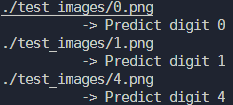
另外在导入模型方面,还可以引入
def restore(self):
saver = tf.train.Saver()
ckpt = tf.train.get_checkpoint_state(CKPT_DIR)
if ckpt and ckpt.model_checkpoint_path:
saver.restore(self.sess, ckpt.model_checkpoint_path)
else:
raise FileNotFoundError("未保存任何模型")
进行错误处理
实际上还是可以像线性回归那边一样加入一个summary来方便用tensorboard来可视化,不过因为我上面跑的还挺成功的,就先不搞这个了,总体上还是比较顺利的